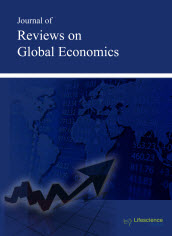Modelling the Dynamic Impact of Replanting Subsidy on Tea Production in Sri Lanka: Policy Analysis Using the ARDL Model Approach
DOI:
https://doi.org/10.6000/1929-7092.2020.09.02Keywords:
ARDL Approach, Cost of Production, Tea Production, Tea Prices, Tea Replanting Subsidy, Sri Lanka.Abstract
The tea industry in Sri Lanka plays a vital role in the economy with its direct and indirect contribution to the gross domestic products, employment, and foreign exchange earnings. The successive governments have introduced subsidy schemes for replanting to increase tea production. However, according to the authors' knowledge, there are no comprehensive quantitative studies undertaken to effectively investigate and quantify the effect of tea replanting subsidy scheme on tea production of the various geographic elevations of tea cultivating lands. The significant contribution of this paper is the quantification of the impact of tea replanting subsidy schemes on tea production in the short-run and long-run at different altitudes. This research takes time series data from 1970 to 2018 of three different heights or elevations-high, medium, and low. The Autoregressive Distributed Lag (ARDL) Model examines the short-run and long-run dynamics of the subsidy scheme on tea production. The results reveal that there is a cointegration between tea production and three variables; tea replanting subsidy, tea prices and tea bearing area; in all three elevations. But tea replanting subsidy is not significant in long run for all three elevations, separately. In the short-run analysis, the impact of replanting subsidy is significant only for tea production in low heights with one-year time lag. Since the study reveals that tea replanting subsidy increases, the tea production of low elevation also increases, and almost 60% of the tea extent and 73% of the total tea production gained from low heights, we recommend that the government continue the tea replanting subsidy schemes as it is benefitted by whole tea industry in long run.
References
Bandula, G.G., Abeywickrama, L.M, De Zoysa, M. (2017), “Factors Influencing the Replanting of Tea Small Holdings in Sri Lanka: A Case Study in The Matara District”, Journal of Advances in Social Science and Humanities,2017; 3(06)
Brown, R., Durbin, L.J., & Evans, J.M. (1975). “Techniques for testing the constancy of regression relationships over time”, Journal of the Royal Statistical Society, 37(2), 149–192.
https://doi.org/10.1111/j.2517-6161.1975.tb01532.x
Cooray, N.S. (1995), ""Behaviour of Primary Commodity Prices and the Economy of Sri Lanka: An Econometric Approach"", The Economic Science, Vol. 43 (3), pp. 61-84
Dickey, D.A., & Fuller, W.A. (1981). “Likelihood ratio statistics for autoregressive time series with a unit root”, Econometrica, 49(4), 1057–1072.
https://doi.org/10.2307/1912517
Halicioglu, F. (2004) “An ARDL Model of International Tourist Flows to Turkey”. Global Business and Economics Review 2004 Anthology, pp.614-624.
Holden, S. T., & Fisher, M. (2015). Subsidies promote use of drought tolerant maize varieties despite variable yield performance under smallholder environments in Malawi. Food Security, Vol. 7, pp. 1225–1238.
https://doi.org/10.1007/s12571-015-0511-4
Karunasena, A.G. (1988). A Macroeconometric Model for Sri Lanka, Central Bank Press, Rajagiriya
Kodituwakku, H. (2001). Econometric Model Building, Tharanjee Prints, Sri Lanka.
Ministry of Plantation Industries – Progress Report, (2015)
Ministry of Plantation Industries, Performance report, (2017)
Narayan, P.K. (2005). “The saving and investment nexus for China: evidence from cointegration tests”, Applied Economics, 37, 1979–1990.
https://doi.org/10.1080/00036840500278103
Perman, R. (1991), “Cointegration: An Introduction to the Literature”, Journal of Economic Studies, Vol 18, No 3, 1991, pp 3-30 © MCB University Press. 0144-3585
https://doi.org/10.1108/EUM0000000000151
Pesaran, M.H., Shin, Y., & Smith, R.J. (2001). “Bounds testing approaches to the analysis of long run relationships”, Journal of Applied Econometrics, 16, 289–326.
https://doi.org/10.1002/jae.616
Pesaran, M.H. and Shin Y. (1999). An Autoregressive Distributed Lag Modeling Approach to Cointegration Analysis, In: Strom, S., Holly, A., Diamond, P. (Eds.), Centennial Volume of Rangar Frisch, Cambridge University Press, Cambridge.
Pravin K. Trivedi. (1992), “ A case study of cocoa replanting and new planting in bahia, brazil 1966–1985”, Journal of Advances in Social Science and Huminities, 3(06), 36227-36235.
https://doi.org/10.1016/0304-3878(92)90041-7
Sri Lanka Tea Board, Statistical Bulletin, (2016)
Tiwari, A.K., Shahbaz, M. (2013), “Modelling the Relationship between Whole Sale Price and Consumer Price Indices: Cointegration and Causality Analysis for India”, Global Business Review, 14(3), 397–411.
https://doi.org/10.1177/0972150913496784
Trivedi, P. K. (1992). A case study of cocoa replanting and new planting in Bahia, Brazil 1966-1985. Journal of Development Economics, Vol. 39, pp. 279–299.
https://doi.org/10.1016/0304-3878(92)90041-7
Weerahewa, J., Kodithuwakku, S. S. S., & Ariyawardana, A. (2010). The fertilizer subsidy program in Sri Lanka. Case Study #7-11 of the Program: “Food Policy for Developing Countries: The Role of Government in the Global Food System” 2010, 12. Retrieved from http://www.environmentportal.in/ files/fertiliser subsidy programme in sri lanka.pdf
Advances in Management & Applied Economics, vol. 7, no. 1, 2017, 31-51 ISSN: 1792-7544 (print version), 1792-7552(online) Science press Ltd, 2017 Evaluating the Fertilizer Subsidy Reforms in the Rice Production Sector in Sri Lanka: A Simulation Analysis
Downloads
Published
How to Cite
Issue
Section
License
Policy for Journals/Articles with Open Access
Authors who publish with this journal agree to the following terms:
- Authors retain copyright and grant the journal right of first publication with the work simultaneously licensed under a Creative Commons Attribution License that allows others to share the work with an acknowledgement of the work's authorship and initial publication in this journal.
- Authors are permitted and encouraged to post links to their work online (e.g., in institutional repositories or on their website) prior to and during the submission process, as it can lead to productive exchanges, as well as earlier and greater citation of published work
Policy for Journals / Manuscript with Paid Access
Authors who publish with this journal agree to the following terms:
- Publisher retain copyright .
- Authors are permitted and encouraged to post links to their work online (e.g., in institutional repositories or on their website) prior to and during the submission process, as it can lead to productive exchanges, as well as earlier and greater citation of published work .






